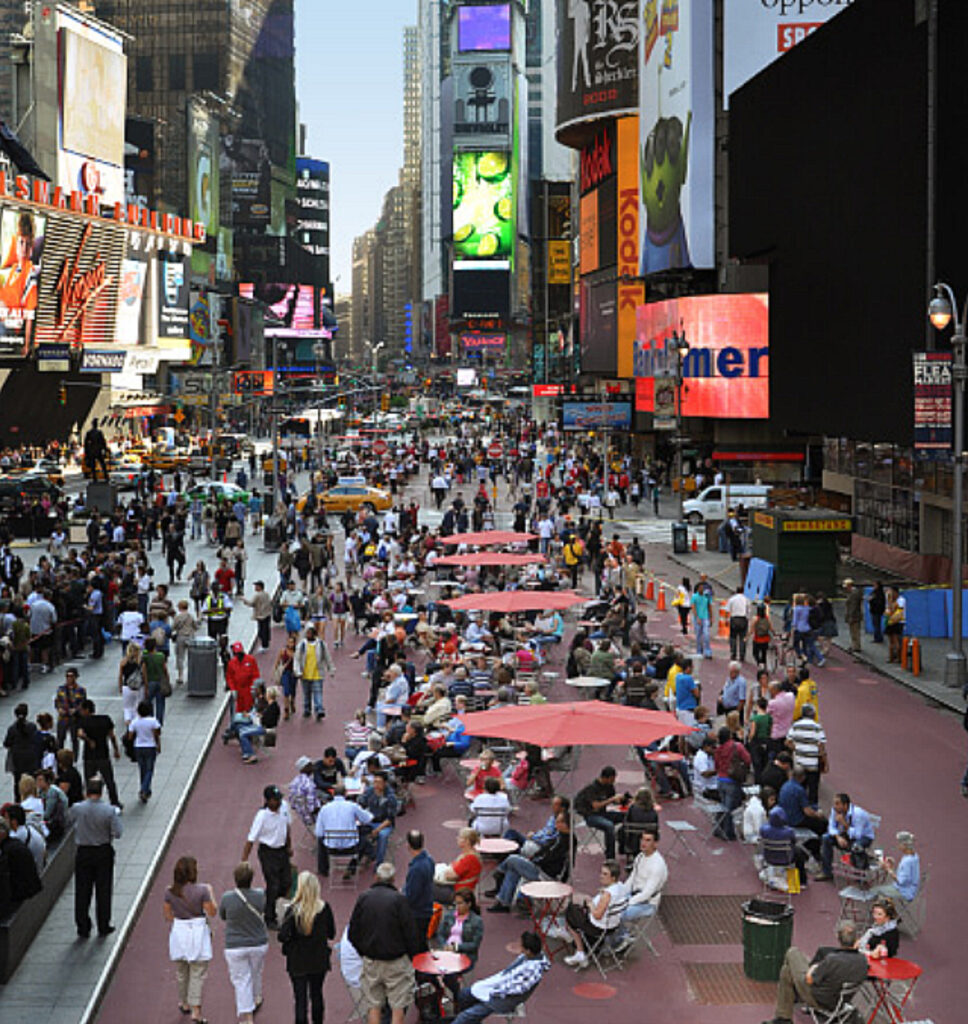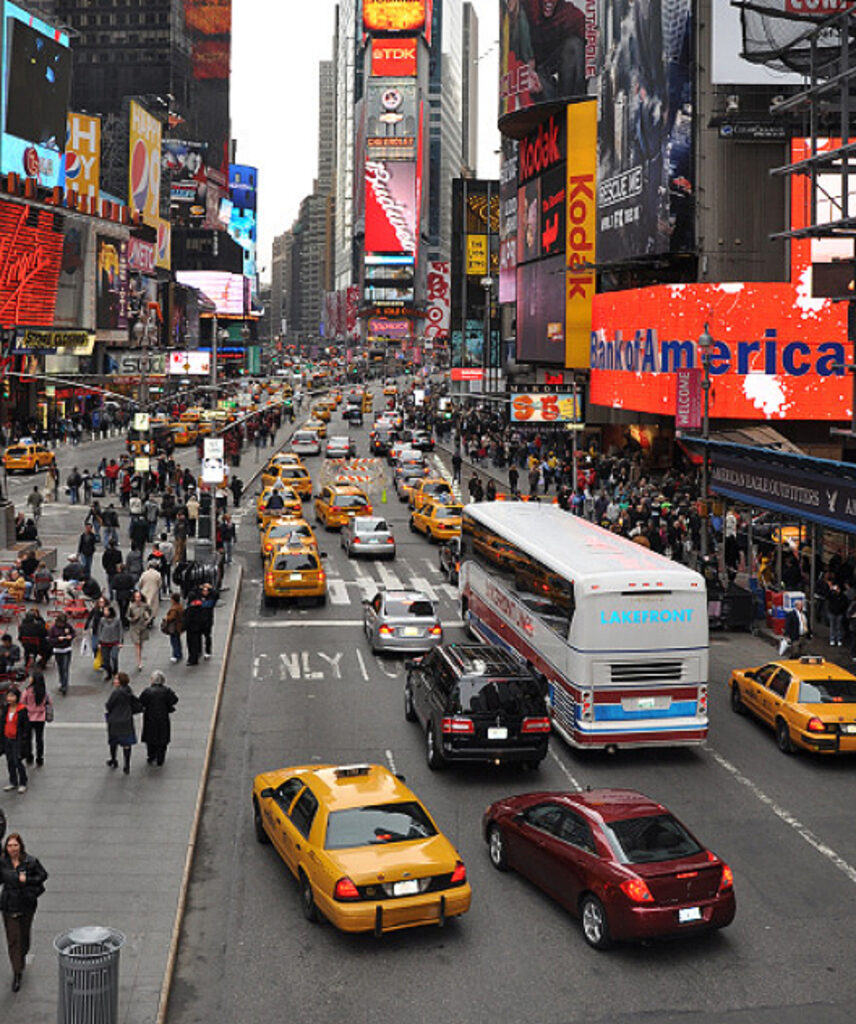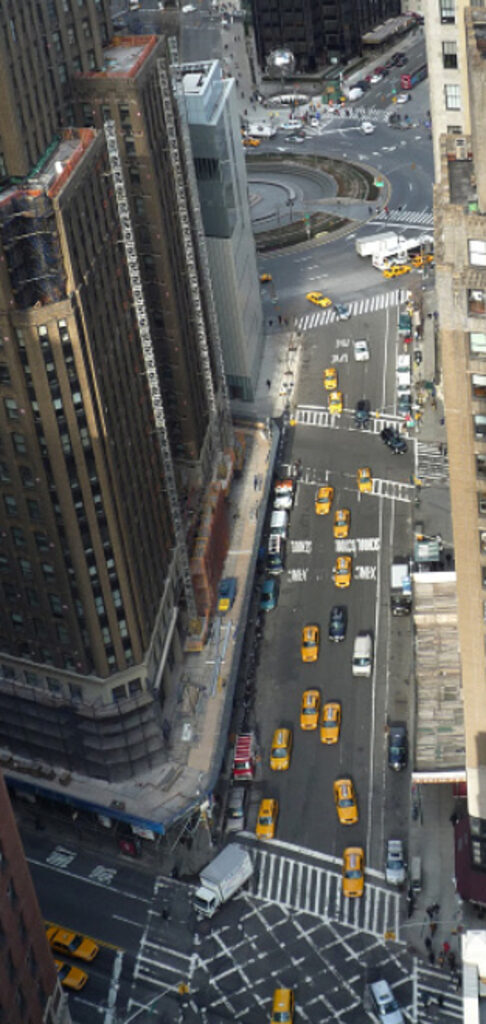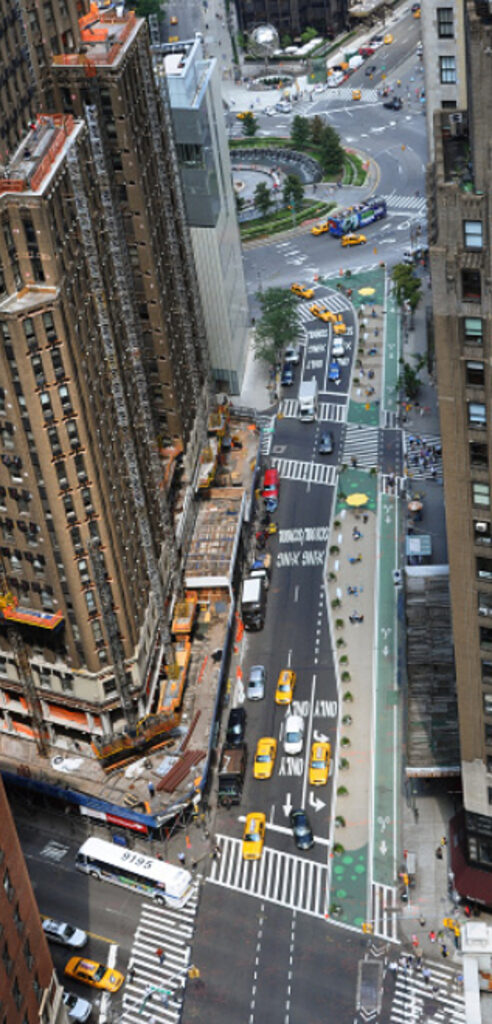| Location | New York City, New York, USA |
| Date | 2009-present |
| Client | City of New York |
| End User | New York City residents and tourists; 70 000 bus riders through Midtown |
| Implementing Agency | New York City Department of Transportation |
| Design Firm | Snøhetta |
| Funder | City of New York |
| Cost | $1.5 million USD |
| Web Resource | www.nyc.gov/html/dot/downloads/pdf/broadway_report_final2010_web2.pdf |

One of the new pedestrian plazas in Times Square, New York City. Photo: New York City Department of Transportation
Times Square, the iconic plaza of New York City, was suffering from its own popularity. Thousands of tourists, commuters and New Yorkers were clogging the sidewalks and slowing down traffic. This congestive “ped-lock” was even driving business away. In the 2003 Times Square Office Worker’s Survey, 68 percent of the respondents listed congestion as the number one reason they would want to work somewhere else. It was also a major public safety issue. From 2002 to 2004, there were 91 vehicle-pedestrian collisions, and 192 vehicle collisions at the intersection of Broadway and West 7th Avenue. On August 7, 2010, the day’s pedestrian count at the same intersection reached 163 215 people.
So in 2009, the New York City Department of Transportation embraced a drastic move, completely closing five blocks of Broadway between 42nd Street and 47th Street to vehicular traffic. Sixty thousand square feet (5400 sq m) of street space was transformed into public plazas.
Now those wishing to linger can stand in the plazas, leaving the sidewalks free for walking. Tables and chairs offer a place to rest and take in the bustling view, enjoy the sights, or escape the office cubicle. The plazas have led to 35 percent less crash-related injuries to pedestrians and reduced the number of people walking in the street by 80 percent. This was a common occurrence due to sidewalk space constraints. Traffic times have improved by 4 percent, a boon for a city where every minute counts.

Times Square before Green Light for Midtown. Photo: New York City Department of Transportation
It may seem counterintuitive that narrowing a street would ease congestion, however, a body of research shows the opposite is true. The design is based on a theory by Dietrich Braess.
In 2010, in response to broad support for the plazas from New York City residents and Times Square workers, Mayor Bloomberg made the plazas permanent. The city is now planning a redesign of the plazas with Norwegian firm Snohetta to incorporate event infrastructure such as television and cable hookups, security features, and dedicated public performance space.
The theory behind the road closures comes from Braess’ Paradox, first put forth by Dietrich Braess in 1968. This mathematical formula states that adding extra capacity to a network, such as a street grid, can reduce overall performance, which Braess proved through a simple experiment: when he added a fifth street to a four-street network, all the vehicles took longer to get through.
The reason being, when you add a new avenue to a crowded street grid, the drivers rush to the new street, creating a new traffic jam on that street and those that feed into it. The flipside of the equation is that you can improve traffic flow by reducing capacity.
Dr. Joel E. Cohen, a mathematician at Rockefeller University in New York, and Dr. Frank P. Kelly, of the University of Cambridge in England, published a more detailed statistical model that used queuing theory, which describes traffic jams in terms of vehicles lining up on the streets. This more sophisticated version of Braess’ original experiment confirmed the original findings, with support from elements of game theory, which states that when everyone acts selfishly (by trying to find the quickest detour or route through a traffic jam), everybody suffers.
One of the major examples occurred in Seoul, South Korea, when mayor Lee Myung Bak decides to daylight the Cheonggycheon River in 2003, which ran through the city center. To create the new 1000-acre park, the Bak had to tear down the highway that had covered it up. Contrary to predictions, traffic improved throughout the city as people took advantage of the newly revamped bus systems and alternative routes.
The New York Department of Transportation drew on these theories and experiments to take away some of the options that drivers had to choose from. Much of Broadway’s traffic was diverted to 7th Avenue, which still continues through the heart of Times Square unimpeded, often with longer green light times; five bus lanes were also redirected to 7th Avenue. This led to a 13 percent increase in bus travel times on 6th Avenue and a 50 percent decrease in wait times for southbound buses on 6th and 7th avenues.


left and right image: Before and after images of Columbus Circle Photos: New York City Department of Transportation















READ OR LEAVE A COMMENT